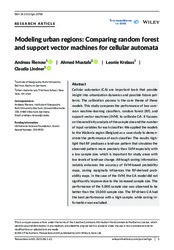Modeling urban regions: Comparing random forest and support vector machines for cellular automata
Rienow, Andreas; Mustafa, Ahmed; Krelaus, Leonie; Lindner, Claudia, 2021: Modeling urban regions: Comparing random forest and support vector machines for cellular automata. In: Transactions in GIS: n/a - n/a, DOI: 10.23689/fidgeo-4420.
 |
Dokument öffnen: |
Cellular automaton (CA) are important tools that provide insight into urbanization dynamics and possible future patterns. The calibration process is the core theme of these models. This study compares the performance of two common machine‐learning classifiers, random forest (RF), and support vector machines (SVM), to calibrate CA. It focuses on the sensitivity analysis of the sample size and the number of input variables for each classifier. We applied the models to the Wallonia region (Belgium) as a case study to demonstrate the performance of each classifier. The results highlight that RF produces a land‐use pattern that simulates the observed pattern more precisely than SVM especially with a low sample size, which is important for study areas with low levels of land‐use change. Although zoning information notably enhances the accuracy of SVM‐based probability maps, zoning marginally influences the RF‐derived probability maps. In the case of the SVM, the CA model did not significantly improve due to the increased sample size. The performance of the 5,000 sample size was observed to be better than the 15,000 sample size. The RF‐driven CA had the best performance with a high sample, while zoning information was excluded.
Statistik:
ZugriffsstatistikSammlung:
- Geographie, Hydrologie [454]
This is an open access article under the terms of the Creative Commons Attribution‐NonCommercial‐NoDerivs License, which permits use and distribution in any medium, provided the original work is properly cited, the use is non‐commercial and no modifications or adaptations are made.

